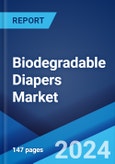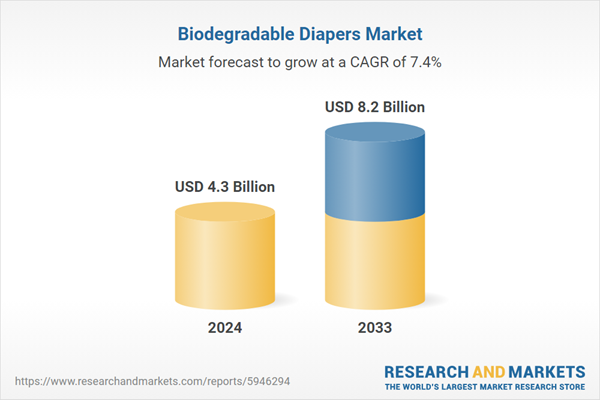The global biodegradable diapers market size reached USD 4.3 Billion in 2024. Looking forward, the publisher expects the market to reach USD 8.2 Billion by 2033, exhibiting a growth rate (CAGR) of 7.5% during 2025-2033. The growing geriatric population, increasing awareness about personal health and hygiene, and the rising prevalence of urinary incontinence represent some of the key factors driving the market.
Competitive analysis such as market structure, market share by key players, player positioning, top winning strategies, competitive dashboard, and company evaluation quadrant has been covered in the report. Also, detailed profiles of all major companies have been provided. The market structure is fragmented with a large number of small and medium-sized players operating in the industry. The volume of new entrants is moderate in the biodegradable diapers industry on account of the low entry barriers and product differentiation in the market. However, consumers have loyalty towards specific brands which increases the threat of new entrants in the market.
What are Biodegradable Diapers?
Biodegradable diapers refer to absorbent items that are designed to defecate and urinate without going to the toilet. They are manufactured from various biodegradable fibers, such as cotton, bamboo, wood pulp, and starch, and widely available in different sizes, shapes, colors, and designs. They are easily decomposed in the environment and can be flushed for the purpose of composting. They are convenient, cost-effective, recyclable, environmentally friendly, and have hypoallergenic and antibacterial properties. As they assist in reducing the risk of infection, skin irritation, rashes, and itching among babies and adults, the demand for biodegradable diapers is increasing around the world.
Rising Prevalence of Urinary Incontinence Augmenting Market Growth
The rising prevalence of urinary incontinence currently represents one of the primary drivers resulting in the increasing sales of biodegradable diapers. This is also resulting in the increase demand for biodegradable diapers, especially among the geriatric population. Moreover, the rising preference for biodegradable diapers to maintain personal hygiene among adults suffering from this disorder is bolstering the growth of the market.Competitive analysis such as market structure, market share by key players, player positioning, top winning strategies, competitive dashboard, and company evaluation quadrant has been covered in the report. Also, detailed profiles of all major companies have been provided. The market structure is fragmented with a large number of small and medium-sized players operating in the industry. The volume of new entrants is moderate in the biodegradable diapers industry on account of the low entry barriers and product differentiation in the market. However, consumers have loyalty towards specific brands which increases the threat of new entrants in the market.
What are Biodegradable Diapers?
Biodegradable diapers refer to absorbent items that are designed to defecate and urinate without going to the toilet. They are manufactured from various biodegradable fibers, such as cotton, bamboo, wood pulp, and starch, and widely available in different sizes, shapes, colors, and designs. They are easily decomposed in the environment and can be flushed for the purpose of composting. They are convenient, cost-effective, recyclable, environmentally friendly, and have hypoallergenic and antibacterial properties. As they assist in reducing the risk of infection, skin irritation, rashes, and itching among babies and adults, the demand for biodegradable diapers is increasing around the world.
COVID-19 Impact:
The COVID-19 pandemic outbreak caused a severe problem for the biodegradable diapers industry and imposed unprecedented challenges on numerous countries. The imposition of the lockdown has forced manufacturers to halt or temporarily shut down their operations. There was a shortage of labor and raw materials due to the fear of the widespread coronavirus. In addition to this, restrictions on cross-border movements have hampered the export and import of biodegradable diapers across the globe. Governing agencies of various countries imposed stringent policies that caused serious supply chain disruptions in the biodegradable diapers industry. Apart from this, the demand for biodegradable diapers declined as consumers were focused on purchasing essential items rather than buying these diapers. Additionally, the rapid spread of COVID-19 has resulted in decreased disposable income of individuals around the world, which affected the purchase of branded baby or adult hygiene biodegradable diapers. However, post-pandemic, governing agencies of various countries have reopened the lockdown, which is projected to increase the sales of biodegradable diapers in the coming years. Moreover, the rising awareness among consumers about utilizing natural and organic products currently is positively influencing the biodegradable diaper market.Biodegradable Diapers Market Trends:
At present, the increasing awareness about maintaining personal hygiene among individuals around the world represents one of the major factors impelling the growth of the market. Moreover, the escalating demand for biodegradable diapers due to rising environmental concerns among the masses worldwide is strengthening the growth of the market. Apart from this, the growing prevalence of urinary incontinence disorder among individuals across the globe is offering a positive market outlook. In addition to this, the rising number of geriatric populations, along with the increasing demand for natural and organic solutions that are chemical free, is contributing to the growth of the market. Besides this, governing agencies of various countries are supporting the utilization of biodegradable diapers to reduce the waste in landfills and decrease carbon footprint around the world is offering lucrative growth opportunities to industry investors. Additionally, the rising demand for biodegradable diapers among babies, as they prevent rashes and itching, is bolstering the growth of the market. In line with this, the wide availability of biodegradable diapers through various distribution channels, such as pharmacies, supermarkets, hypermarkets, and convenience and online stores, is propelling the growth of the market. Furthermore, key players are introducing innovative biodegradable baby diapers with non-chlorine, latex, and dye-free materials, which is supporting the growth of the market.Key Market Segmentation:
The publisher provides an analysis of the key trends in each sub-segment of the global biodegradable diapers market report, along with forecasts at the global and regional level from 2025-2033. Our report has categorized the market based on raw material, end-user and distribution channel.Raw Material Insights:
- Cotton/Wood pulp
- Bamboo
- Starch
- Others
End-User Insights:
- Babies
- Adults
Distribution Channel Insights:
- Pharmacies
- Supermarkets and Hypermarkets
- Convenience Stores
- Online
- Others
Regional Insights:
- North America
- Europe
- Asia- Pacific
- Latin America
- Middle East and Africa
Competitive Landscape:
The report has also provided a comprehensive analysis of the competitive landscape in the global biodegradable diapers market.Some of the companies covered in the report include:
- Earth's Best (Hain Celestial)
- Bamboo Nature
- Seventh Generation
- Kimberely-Clark
- GroVia
- Naty AB
- The Honest Company
- Ontex Group
- Babyganics
- Unicharm
- Pamper
- Flip Diaper
- Bumkins Company
Key Questions Answered in This Report
- 1. What was the size of the global biodegradable diapers market in 2024?
- 2. What is the expected growth rate of the global biodegradable diapers market during 2025-2033?
- 3. What are the key factors driving the global biodegradable diapers market?
- 4. What has been the impact of COVID-19 on the global biodegradable diapers market?
- 5. What is the breakup of global biodegradable diapers market based on the raw material?
- 6. What is the breakup of global biodegradable diapers market based on the end-user?
- 7. What is the breakup of global biodegradable diapers market based on the distribution channel?
- 8. What are the key regions in the global biodegradable diapers market?
- 9. Who are the key players/companies in the global biodegradable diapers market?
Table of Contents
1 Preface3 Executive Summary
2 Scope and Methodology
4 Introduction
5 Global Biodegradable Diapers Market
6 Market Breakup by Raw Material
7 Market Breakup by End-User
8 Market Breakup by Distribution Channel
9 Market Breakup by Region
10 Biodegradable Diapers Manufacturing Process
11 Competitive Landscape
List of Tables
Companies Mentioned
- Earth's Best (Hain Celestial)
- Bamboo Nature
- Seventh Generation
- Kimberely-Clark
- GroVia
- Naty AB
- The Honest Company
- Ontex Group
- Babyganics
- Unicharm
- Pamper
- Flip Diaper and Bumkins Company
Table Information
| Report Attribute | Details |
|---|---|
| No. of Pages | 134 |
| Published | January 2025 |
| Forecast Period | 2024 - 2033 |
| Estimated Market Value ( USD | $ 4.3 Billion |
| Forecasted Market Value ( USD | $ 8.2 Billion |
| Compound Annual Growth Rate | 7.4% |
| Regions Covered | Global |
| No. of Companies Mentioned | 12 |









